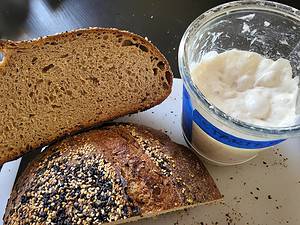
That’s where it all starts: at the start, or with a starter. With that gooey, bubbly, creamy mess of flour, water, and beneficial microbes.
Making a sourdough starter is the process of making a preferment, that is, allowing flour and water to ferment over a week or so and thus setting up a host environment containing beneficial microbes. People have come up with various types of preferments − among them levain, poolish, biga, and sponge. Preferments are then added to the main dough to jumpstart an otherwise lengthy fermentation process. This batch of ingredients is called the final dough.
No industrial Baker’s Yeast
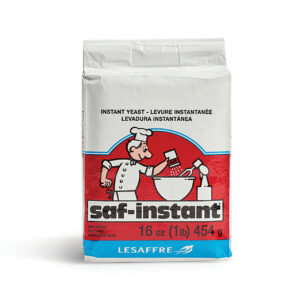
No Baker’s yeast, baking powder, or baking soda is used in making sourdough starter and subsequent levain. And that is the beauty of it. A finished sourdough starter or levain is not created with modern, industrialized ingredients – no matter how efficient they may be for a savvy baker in producing otherwise good-enough bread.
Using instant yeast instead of sourdough starter will make the bread rise while reducing the need for lengthy fermentation time. That is why industrial bakers favor commercial yeast. However, a reduced fermentation period will also hinder the development of desirable sourdough flavors. Some savvy bakers add honey to sweeten things and hope to make sales. Not so the fine bakers of old-school sourdough bread.
Levain is an offspring of a finished or ripe sourdough starter made with the most natural ingredients of flour and water. The naturally occurring microbes of wild yeast and lactobacillus will do their job and imbue flour and water with the capacity to bake amazing sourdough bread. In short, wild yeast will act as the leavening agent and produce the rise in the loaf, while lactobacillus will produce the sour tang, that is, the sourdough flavor of the loaf.
Making a Sourdough Starter takes Time
I once followed a standard online recipe for making sourdough starter − and there are many out there − which took some short five days. Other instructions advocate for more than five days, which is fine − the longer, the better. The desired microbial cultures that come alive in the mix of flour and water do need their due time to colonize the mix by multiplying and becoming overactive.
Five days only, but it worked. After regularly feeding the emerging cultures for five days, which included discarding large portions of the batches each day, I had a starter that seemed rich enough in microbial activity to jumpstart the fermentation of a main dough of whole wheat flour, water, and salt. However, my early baked loaves were a bit flat − although tasty. The loaves did not rise a lot; perhaps the cultures in the starter/levain were just not that strong yet. I do not know for sure.
In any case, the following link to The Perfect Loaf blog provides a beginning home baker with good guidelines as to make a sourdough starter.
7 Easy Steps to Making an Incredible Sourdough Starter From Scratch
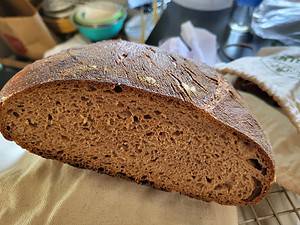
There are a lot of factors in the sourdough preparation and baking process that can undermine a home baker’s aspirations at any time. It is practice that makes perfect, literally. It took me about a dozen prep and baking attempts over a couple of months to iron out most of the kinks in baking sourdough bread. But these details are for another story.
At last, my starter’s cultures became proficient and have been so ever since. They have survived days of neglect in the refrigerator, hot weather in Summer months, and a change from being fed with whole wheat flour to bread flour at once. Wild yeast and lactobacillus are now my friends.
When a home baker begins developing a sourdough starter, s/he must discard large portions of the batches per each feeding event. It takes time for beneficial bacteria to outcrowd some of the possibly nasty bacteria in the early stages of the starter. A home baker cannot tell which microbe is in charge during the starter’s birth. However, it is said that wild yeast and lactobacillus will eventually win the competition to colonize the mix of flour and water − called the sourdough starter.
This process may take at least five days or more. That is to say, do not use any discard from these formative early days of the microbial colony to bake any recipes. Doing so may not be that safe yet.
In any case, it is also true that baking a loaf at 475°F for 30 minutes or to an internal temperature of 190°F will sacrifice all microbes, good and bad, as they cannot survive these high temperatures.
My Bout with Cultures

In my early days of rediscovering homemade sourdough bread, I had my starter fed with whole wheat flour. After some month or two, the starter began to smell rancid, worse than very old cheese dunked in gasoline. I still baked perfectly good bread with it, to be honest. Nobody died. But my family and I could not stand the strongly offputting odor for long.
There was no mold in or on the starter. However, I decided to keep feeding that starter with bread flour instead of whole wheat flour. After four or five feedings with bread flour over a week, the starter began to smell better and changed its color from reddish to beige.
I have been nurturing the same starter ever since, with splendid results and no discard. Here is how I eliminated discarding so much flour.
No Discard in my Home
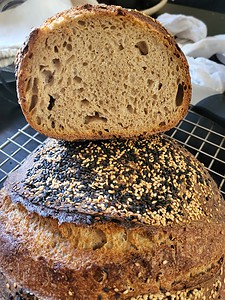
Well, it is no secret that most home bakers feel uneasy having to discard flour spent as fuel by microbes continuously. Some use that discard in other recipes. I used my discard to fertilize my backyard garden. Now, I found a more efficient way.
Let’s say I now have 200g of a ripe and lively starter in glass jar #1: flour, water, and imbued cultures that are creating bubbles in the mix. The starter smells pleasantly aromatic of wheat and a touch of vinegar. However, a certain sourdough recipe calls for 300g of starter or, more professionally, levain. How do I do?
Well, for once, I create 300g of an offspring of the ripe starter called levain for the recipe.
First, I separate 180g of the starter-at-hand and place that portion in a spare jar #2. That leaves 20g of ripe starter in the jar #1.
Secondly, I feed the portion in jar #2 with 60g of water and 60g of flour to bring the mass in jar #2 to 300g. I stir all and let rest until the mass has risen sufficiently to indicate that the microbes have consumed the freshly added food and are plenty and active. That, then, is my required levain: an offspring of my starter.
Thirdly, I take all this levain, thus emptying jar #2, and mix it into the main dough according to the recipe.
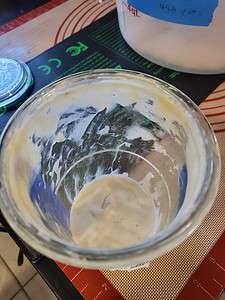
Now, jar #1 still contains 20g of ripe starter or culture. Fourthly, I feed that culture with a desired ratio of water and flour. Feeding the 20g of remaining culture at a ratio of, let’s say, 1:1:1 means adding to 20g of culture an additional 20g of water and 20g of flour for a total mass of 60g. I stir again, and let it all rest for a day or two in a cool environment. A second feeding with a ratio of 1:1:1 will bring the total mass of starter/culture to 180g, nearly to the level of where it started, and all without discard.
For as long as the starter/culture, even with only 20g in the jar to begin with, is kept strong with regular feedings, the beneficial microbes should remain to rule the day, err dough.
In any case, a starter’s established culture is very forgiving. I have not been able to kill my culture. Whether I feed them with a 1:1:1 or 1:3:3 ratio, every day or only every two to three days, in a warm or in cool environment, they always seem to come back into activity. I do not think much of flour or water per se when thinking of my starter or levain, but I think about the little microbes in it and how I can keep them alive. At any moment, they can be in a state of near-death or hibernating in deep sleep or just in a sweet afternoon slumber, in a state of waking up and being hungry, in a state of having been fed and burping all over, or somewhere in between. They are my pets.
Feeding ratios and schedules are helpful, but they are only what they are: general guidelines. I have broken all these conventions and continue to do so as I please. But I am keenly aware that on prep day, I need to have a levain ready full of active microbes. There is no fiddling at that moment.
What does Levain with plenty of active Microbes look like?
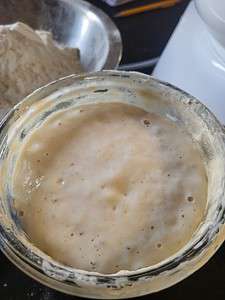
What does a levain with plenty of active microbes in it look like? Well, when the microbes are plenty and active, they feed on the added flour and multiply. They then also produce visible bubbles, which makes the starter substantially rise in volume. The top of the starter will look a bit domed in the jar.
When all this is said and done, the domed surface of the gooey mess will begin to concave and look like the inside of a bowl. The volume will decline little by little.
The best time for the levain to be mixed in with the main dough is right there and then, after the cultures peaked in their activities and the gooey mess began to retreat in volume. The microbes are still warmed up and ready to ferment the fresh food in the main dough.